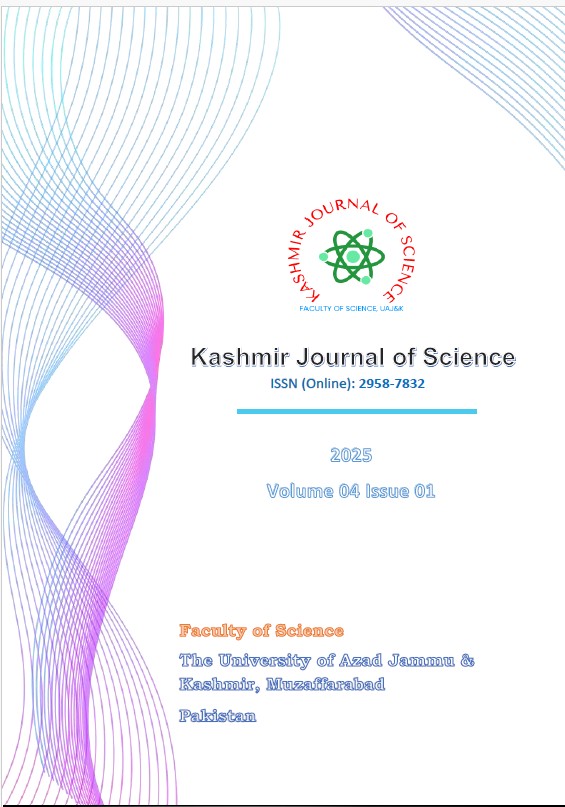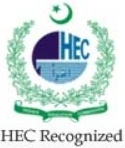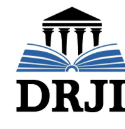The Nutritional Analysis, Phytochemical and Antifungal Study of Equisetum arvense L. From Village Kharkay Pak Afghan Border District Dir Lower, Pakistan
DOI:
https://doi.org/10.63147/krjs.v4i01.85Keywords:
Phytochemistry, antifungal, nutritional analysis, Equisetum arvense L, Dir lower, PakistanAbstract
The objective of the present study was to study the nutritional analysis, and antifungal activities and find out the presence of phytochemicals in the aqueous, ethanol, and methanol extracts of Equisetum arvense L collected from different areas of Khyber Pakhtoon Khwa by both quantitative and qualitative screening methods. In qualitative analysis, the phytochemical compounds such as alkaloids, tannins, Phlobatannins, flavonoids, carbohydrates, phenols, saponin, cardiac glycosides, proteins, volatile oils, resins, glycosides, and terpenoids were screened. In quantitative analysis, the phytochemical compounds such as total phenolic and total flavonoids were quantified. The ethanolic fern extract performed well to show positivity rather than aqueous and methanolic extracts for the 13 phytochemicals. In quantitative analysis, the important secondary metabolite total phenol and total flavonoid content were tested. The ethanolic extract of total flavonoids and total phenol content were the highest. Also comparatively studied for nutritional analysis. Ash in Sample from junikalay 26.44%, 22.83%, in sample from Shahi Benshay and 6.01% in sample from Bara Bala. Moisture was found at 18.69% in a sample from Bara Banda and the lowest amount was found in Shahi at 10.27%. Protein highest amount was found in a sample from Chmarks at 4.37% and the lowest amount was found in a sample from Kas Kuruna at 0.85 %. Fats' highest amount was 74.27% in a sample from Bara Banda and the lowest amount was found in a sample from Shahi Benshay 47.17%. The antifungal activity of all samples collected from different areas showed inhibition against each fungal strand. The most active among the plants was a sample from Joni Klay with a 17.00mm zone of inhibition.
References
Agrahar-Murugkar D, Subbulakshmi G. Nutritional value of edible wild mushrooms collected from the Khasi hills of Meghalaya. Food Chemistry. 2005; 89(4):599-603.
Akinniyi JA, Waziri M. Proximate Value and Mineral Content of the Shoot of Borassus Aethiopummart (GIGINYA). Journal of Chemical Society of Nigeria
Anyasor GN, Ogunwenmo O, Oyelana OA, Akpofunure BE. Phytochemical constituents and antioxidant activities of aqueous and methanol stem extracts of Costus afer Ker Gawl. (Costaceae). African Journal of Biotechnology. 2010; 9(31):4880-4884.
Ayoola GA, Lawore FM, Adelowotan T, Aibinu IE, Adenipekun E, Coker HAB. Chemical analysis and antimicrobial activity of the essential oil of Syzigium aromaticum (clove). African Journal of Microbiology Research. 2008; 2(7):162-166.
Barile L, Messina E, Giacomello A, Marbán E. Endogenous cardiac stem cells. Progress in cardiovascular diseases, 2007; 50(1):31-48.
Bussau VA, Fairchild TJ, Rao A, Steele P, Fournier PA. Carbohydrate loading in human muscle: an improved 1 day protocol. European journal of applied physiology. 2002; 87(3):290-295.
Chang HC, Gupta SK, Tsay HS. Studies on Folk Medicinal Fern: An Example of “Gu-Sui-Bu”. In Working with Ferns Springer New York. 2011, 285304.
Daffodil ED, Rajalakshmi K, Mohan VR. Antioxidant activity, total phenolics and flavonoids of Salicornia brachiata Roxb. Leaf extracts (Chenopodiaceae). World J. of Pharmacy and Pharmaceutical Sciences.
Dahiru D, Onubiyi JA, Umaru HA. Phytochemical screening and antiulcerogenic effect of Moringa oleifera aqueous leaf extract. African Journal of Traditional, Complementary and Alternative medicines (AJTCAM). 2006; 3(3):70-75.
Dahiru, D, Onubiyi JA, Umaru HA. Phytochemical screening and antiulcerogenic effect of Moringa oleifera aqueous leaf extract. African Journal of Traditional, Complementary and Alternative medicines (AJTCAM). 2006; 3(3):70-75.
Dharmananda S. Gallnuts and the uses of Tannins in Chinese Medicine. ITM. 2003.
Dozier III WA, Kerr BJ, Corzo A, Kidd MT, Weber TE, Bregendahl K. Apparent metabolizable energy of glycerin for broiler chickens. Poultry Science, 2008; 87(2):317-322.
Gibson LF. Bacteriocin activity and probiotic activity of Aeromonas media. Journal of applied microbiology. 1998; 85(1).
Haque E, Lo V, Minett AI, Harris AT, Church TL. Dichotomous adsorption behaviour of dyes on an aminofunctionalised metal–organic framework, amino-MIL101 (Al). Journal of Materials Chemistry A
Hasler CM, Blumberg JB. Introduction. The Journal of nutrition. 1999; 129(3):756-757.
Hodek P, Trefil P, Stiborová M. Flavonoids-potent and versatile biologically active compounds interacting with cytochromes 450. Chemico-biological interactions, 2002; 139(1):1-21.
Hossain MA, Nagooru MR. Biochemical profiling and total flavonoids contents of leaves crude extract of endemic medicinal plant Corydyline terminalis L. Kunth. Pharmacognosy Journal. 2011; 3(24):25-30.
Iwashina T, Matsumoto S. Flavonoid Properties of six Asplenium species in Vanuatu and New Cale¬ donia, and Distribution of Flavonoid and Related Compounds in Asplenium. Bull Natl Mus Nat Sci. 2011, 133-45.
Just MJ, Recio MC, Giner RM, Cuéllar MJ, Máñez S, Bilia AR, et al. Anti-inflammatory activity of unusual lupane saponins from Bupleurum fruticescens. Planta medica, 1998; 64(05):404-407.
Kam PCA, Liew S. Traditional Chinese herbal medicine and anaesthesia. Anaesthesia. 2002; 57(11):.1083-1089.
Kashmir). Int J Pharm Pharm Sci. 2013; 5(4):632-637.
Khan, G.Z., Ali, A., Ahmad, S., Khan, M.A., Ullah, M.I., Junaid, H., Rabi, F., Sardar, F. and Jan, A., Challenges in HCI Design for Immersive Environments: A Systematic Literature Review.
Khan, S., Jan, G., Bibi, H., Ullah, K. and Ullah, S., Antimicrobial, phytochemical and traditional studies of selected medicinal plant in Bajaur agency, Pakistan.
Khandelwal N, Kross EK, Engelberg RA, Coe NB, Long AC, Curtis JR. Estimating the effect of palliative care interventions and advance care planning on ICU utilization: a systematic review. Critical care medicine/.2015; 43(5):1102.
King AMY, Young G. Characteristics and occurrence of phenolic phytochemicals. Journal of the American Dietetic Association. 1999; 99(2):213-218.
Kirtikar KR, Basu BD. Terminalia chebula. Indian medicinal plants. 1935; 1:1020-1023.
Kokate A, Li X, Jasti B. HPLC detection of marker compounds during buccal permeation enhancement studies. Journal of pharmaceutical and biomedical analysis. 2008; 47(1):90-194.
Kumar DS, Tony DE, Kumar AP, Kumar KA, Rao DBS,
Mathai K. Nutrition in the adult years. Krause’s Food, Nutrition, and Diet Therapy, 10th ed., ed. LK Mahan and S. Escott-Stump. 2000; 27:274-275.
Meagher EA, Barry OP, Burke A, Lucey MR, Lawson JA, Rokach J. et al. Alcohol-induced generation of lipid peroxidation products in humans. The Journal of clinical investigation. 1999; 104(6):805-813.
Moorachian ME. Phytochemicals: Why and how. Tastings, 2000; 7:4-5.
Nadendla R. A review on Abelmoschus esculentus (Okra). Int. Res J Pharm. App Sci. 2013; 3(4):29-132.
Nisar PJ, Scott HJ. Myocutaneous flap reconstruction of the pelvis after abdominoperineal excision. Colorectal disease. 2009; 11(8):806-816.
Nobori T, Miura K, Wu DJ, Lois A, Takabayashi K, Carson DA. Deletions of the cyclin-dependent kinase-4 inhibitor gene in multiple human cancers. Nature. 1994; 368(6473):753.
Parekh J, Chanda S. Antibacterial and phytochemical studies on twelve species of Indian medicinal plants. African Journal of Biomedical Research. 2007; 10(2).
Pirzada Z, Personick M, Biba M, Gong X, Zhou L, Schafer W. et al. Systematic evaluation of new chiral stationary phases for supercritical fluid chromatography using a standard racemate library. Journal of Chromatography A. 2010; 1217(7):1134-1138.
Rajesh KD, Vasantha S, Panneerselvam A, Rajesh NV, jeyathilakan N. phytochemical analysis, in vitro antioxidant potential and gas chromatographyǧmass spectrometry studies of dicranopteris linearis. Asian J Pharm Clin Res. 2016; 9(2):1-6.
Samie A, Tambani T, Harshfield E, Green E, Ramalivhana JN, Bessong PO. Antifungal activities of selected Venda medicinal plants against Candida albicans, Candida krusei and Cryptococcus neoformans isolated from South African AIDS patients. African Journal of Biotechnology. 2010; 9(20).
Shakoor AM, Mishra AK, Reshi ZA, Sharma MP. Preliminary phytochemical screening of some Pteridophytes from District Shopian (Jammu &
Sharma BD, Vyas MS. Ethnobotanical studies on the ferns and fern allies of Rajasthan. Nelumbo. 1985; 27(14):90-91.
Shimada T. Salivary proteins as a defense against dietary tannins. Journal of chemical ecology. 2006; 32(6):11491163.
Shinozaki J, Shibuya M, Masuda K, Ebizuka Y. Dammaradiene synthase, a squalene cyclase, from Dryopteris crassirhizoma Nakai. Phytochemistry. 2008; 69(14):2559-2564.
Singh G, Rawat GS. Ethnomedicinal survey of Kedarnath wildlife sanctuary in western Himalaya, India. Indian Journal of Fundamental and Applied Life Sciences. 2011; 1(1):35-46.
Soni J, Ansari U, Sharma D, Soni S. Predictive data mining for medical diagnosis: An overview of heart disease prediction. International Journal of Computer Applications. 2011; 17(8):43-48.
Soni J, Ansari U, Sharma D, Soni S. Predictive data mining for medical diagnosis: An overview of heart disease prediction. International Journal of Computer Applications. 2011; 17(8):43-48.
Thitilertdecha N, Teerawutgulrag A, Rakariyatham N. Antioxidant and antibacterial activities of Nephelium lappaceum L. extracts. LWT-Food Science and Technology. 2008; 41(10):2029-2035.
Uddin A, Lundberg N. Unroofing history of the eastern Himalaya and the Indo-Burman Ranges: Heavy-mineral study of Cenozoic sediments from the Bengal Basin, Bangladesh. Journal of Sedimentary Research. 1998; 68(3).
Ullah, S., 2019. Phytochemicals Screening and Chromatographic Separation of Bio-Active Compound from the Roots of Berberis Lyceum. Journal of Biotechnology & Bioinformatics Research. SRC/JBBR-101. DOI: Doi. org/10.47363/JBBR/2019 (1), 101, p.3.
Ullah, S., Begam, L., Abasi, F., Khan, S., Bacha, I., Sohil, M. and Ihsan, M.,2019. Floristic list and biological spectra of plants of Arrang Sire Ghar, Bajaur district of Khyber Pakhtoonkhwa, Pakistan. International Journal of Horticulture and Food Science, (1): 103-110.
Ullah, S., Shakir, L. and Ullah, R., 2023. Morphological and Phytochemical Study of Cirsium Arvense from District Mardan Pakistan. J Bioinfo Biotech Res, 1(1), pp.1-7.
Ullah, S., Sohil, M., Khattak, M., Ihsan, M. and Begum, L.2019. List of some selected pteridophytes from Maidan valley of Dir lower Khyber Pakhtunkhwa Pakistan. International Journal of Horticulture and Food Science, 1(2): 15-22.
Ullah, S., Ullah, Z., Iqbal, J., Abasi, F., Khan, S., Sohail, M. and Ihsan, M., 2021. Cheek list of ethnobotanical plants of tehsil colony, Samarbagh, District Dir lower, Khyber Pakhtunkhwa Pakistan. International Journal of Agriculture and Nutrition 2664-6072.
Ullah, S., Ullah, I., Khan, M., Zamir, M., Khan, B.T., Naz, R., Sohil, M., Ihsan, M. and Abasi, F.2019. Phytochemical analysis and antibacterial activity of Ajuga bracteosa, Bergenia ciliate, and Amaranthus viridis from District Lower Dir Village Maidan Banda of Khyber Pakhtunkhwa Pakistan. International Journal of Biosciences (IJB), 14, No. 5, p. 403-412.
Wadood A, Ghufran M, Jamal SB, Naeem M, Khan A, Ghaffar R. Phytochemical analysis of medicinal plants occurring in local area of Mardan. Biochem Anal Biochem, 2013.
Downloads
Published
Issue
Section
License
Copyright (c) 2025 Shakir Ullah, Lubna Shakir, Shahab Ali, Ghani Subhan, Mohammad Sohail, Izhar Khan, Sajid Ali

This work is licensed under a Creative Commons Attribution-NonCommercial 4.0 International License.
This work is licensed under CC BY-NC 4.0







